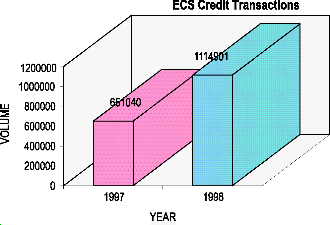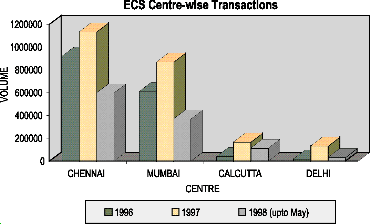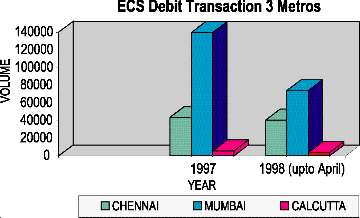Chapter VI
6.1. By the early 90s, MICR computerised cheque clearing operations at the 4 metropolitan centres i.e. Mumbai, Calcutta, Chennai and New Delhi had stabilised. However, the volumes in cheque clearing continued to reflect an upward trend, creating considerable pressure on the existing work flow processes. A closer analysis revealed that 'at par' items such as dividend and interest warrants issued by various corporates were contributing significantly to the volumes in clearing. The existing system of paying interest / dividend to the beneficiaries through paper instruments is also fraud prone with frequent reports of postal interception and encashment, often resulting in the real beneficiaries not getting their dues at all, or at other times getting delayed payments.
6.2. It was decided that a system needed to be put in place that would (i) decrease the volumes of paper instruments in MICR clearing and (ii) improve customer service by ensuring prompt and secure interest/dividend payments to the beneficiaries. Such a system needed to be cost-effective and serve as an alternate method of effecting bulk, low value, recurring payment transactions, thereby obviating the need to issue and handle paper instruments. Electronic Clearing Service (ECS) Credit scheme provided the answer to these problems.
6.3. In ECS Credit a series of electronic payment instructions are generated to replace paper instruments. The system works on the basis of one single debit transaction triggering a large number of credit entries. These credits or electronic payment instructions which possess details of the beneficiary's account number, amount and bank branch, are then communicated to the bank branches through their respective service branches for crediting the accounts of the beneficiaries either through magnetic media duly encrypted or through hard copy.
6.4. User institutions, usually corporate bodies/government departments which have to effect payments to large number of beneficiaries submit details of payments in magnetic media to the bank managing the clearing house, through a Sponsor Bank. The user institutions are required to obtain mandates from beneficiaries, for crediting their accounts under ECS. The corporate bodies too should on their own, advice the beneficiaries about the due date of credit under ECS.
6.5. The minimum number of transactions per user institution is 2,500, with upper limit in value of any single item being restricted to Rs.1,00,000/-. A very low service charge has been prescribed under the scheme to promote ECS.
6.6. ECS Credit service is available as on 1.09.98 at all the 16 offices of the RBI viz., Mumbai, Calcutta, Chennai, New Delhi, Ahmedabad, Bangalore, Hyderabad, Kanpur, Nagpur, Jaipur, Patna, Guwahati, Bhubaneshwar, Thiruvananthapuram, Chandigarh and Pune (SBI). Plans are on the anvil to progressively increase the number of centres with large volume of business covered under the scheme.
<6.7. There are forty-four user institutions which are using ECS Credit scheme presently. Under the existing scheme a user institution has to make different submissions of data when it has to make payments to beneficiaries spread across the various cities, where ECS is currently operative. In future it is a distinct possibility that a corporate body can furnish the ECS Credit meant for different centres at one centre. The NCC / Clearing agency would sort the records on the basis of city code and transmit the file to the relevant destination. On a trial basis inter-city ECS was attempted with one corporate entity submitting payment details relating to Chennai and Mumbai through their corporate entity's sponsor bank to NCC, Mumbai.
 Fig. 6.0. ECS Credit Transactions
Fig. 6.0. ECS Credit Transactions Fig. 6.1. ECS Credit Centre-wise transactions
Fig. 6.1. ECS Credit Centre-wise transactions6.8. Electronic Clearing Service - Debit, is a scheme which facilitates payment of charges to utility services such as electricity, telephone companies, payment of insurance premia and loan instalments etc. by customers. The scheme has been introduced at Chennai and Mumbai for collection of telephone bills by Madras Telephones and MTNL, Mumbai respectively in 1996. In 1997, Calcutta Telephones also joined the ECS Debit scheme.
6.9. ECS Debit envisages a large number of debits resulting in a single credit simultaneously. ECS Debit works on the principle of pre-authorised debit system under which the account holders' account is debited on the appointed date and the amounts are passed on to the utility companies. The scheme thus facilitates:
- faster collection of bills by companies;
- better cash flow management; and
- eliminates the need to go to collection centres/designated banks by the customers.
6.10. All precautions with regard to data validation and integrity as followed under ECS Credit are observed in full under ECS Debit as well. The individual transaction limit under the scheme has been fixed at Rs.25,000/- which is proposed to be raised shortly to Rs.50,000/-.
 Fig. 6.2. ECS Credit Centre-wise transactions
Fig. 6.2. ECS Credit Centre-wise transactions 6.11. For ECS Debit (which operates under the pre-authorised debit ambit), to become widely accepted and popular, it is essential that consumers have faith in the correctness of the bill amounts raised on them by the utility companies. A blanket permission to debit the account could result in excess payment to the utility company in the event of any wrong billing. Thereafter the consumer has to arrange for recovering the excess paid amount from the utility company. To obviate this difficulty, a variant of ECS Debit called 'ECS Utility Bills Payment RAPID has been introduced on a trial basis for the benefit of BEST consumers in two suburbs of Mumbai. The acronym RAPID stands for Receipt and Payment Instruments/Documents.
6.12. RAPID is a post verification debit scheme. The consumer verifies the bill and has the option to pay the bill either in cash or can authorise the bank branch to debit his account. In this scheme the utility company prepares its bills in three parts. The first part serves as a receipt to the customer, the second serves as a voucher for the collecting branch and the third part which contains a MICR band is sent to the service branch. The first part of the receipt is returned to the customer by the collecting branch duly affixing the paid stamp.
6.13. The collecting bank's service branches need to be equipped with a Personal Computer (PC) attached to a small MICR Reader/Encoder to enable them to capture the data in the third part of the bill which has the MICR read band. The service branches transmit data to the NCC.
6.14. At NCC, accounts of the various collecting banks are debited and the account of the Sponsor Bank is credited. The necessary reports containing details of all bills paid are generated by NCC and delivered to the Sponsor Bank. The scheme is beneficial to corporates as they get the amounts due to them on the stipulated date and is useful to customers as they are now in a position to verify the accuracy of the billed amounts, before effecting payment.
6.15. The Retail EFT scheme enables an account holder of a bank to transfer funds to another person having an account with any of the participating commercial banks, without any physical movement of instruments from one centre to another centre. This scheme is meant for small value funds transfer, and it uses RBINet as its carrier.
6.16. The EFT scheme is operational in the 4 metropolitan centres. 4500 branches of the 27 public sector banks at the four metropolitan cities are covered under EFT scheme. At a later date it is proposed to extend the scheme to Bangalore and Hyderabad. The Retail EFT system enables both intra and inter-bank funds transfer, within a city and between cities. Since the scheme is retail in nature the maximum amount permitted for transfer per transaction is Rs.1,00,000/-.
6.17. The EFT process cycle is spread over 3 days. Funds are made available to the beneficiary on a T+1 basis.
6.18. The charges payable by the customers has been decided by Service Charges Committee of the Indian Banks Association (IBA).
6.19. Automated Teller Machines (ATMs) are primarily used for performing some of the banking functions such as withdrawal of cash or deposit of cash/cheque etc., by using an ATM card. Each customer is provided with an ATM card with a unique Personal Identification Number (PIN). Whenever a customer performs a transaction,the person has to key in the PIN which is validated by the ATM, before the machine permits any transaction. The PIN has to be kept secret by the customer, to prevent any misuse or fraudulent transactions in the event of loss of the card.
6.20. Stand-alone ATMs made their appearance in India, in the early 1990s. These were mostly installed by foreign banks in their branch premises, as per the then existing policy. Easing of restrictions on the location of ATMs has led to their being installed at convenient places such as airports, central business districts, hospitals etc.
6.21. IBA has set up a Shared Payment Network System (SPNS) or SWADHAN network of ATMs of its member banks in Mumbai. The network went live on February 1, 1997. The objective behind the SWADHAN network is to provide 24 hours, 7 days in a week and 365 days in a year, electronic banking service to the customer of a member bank any where in the city of Mumbai.
6.22. The member banks which participate in the network issue cards to their customers for transacting on SWADHAN network. The customer is free to conduct transactions at the ATMs of any of the member banks located in the neighbourhood. The services offered under SPNS are cash withdrawal, balance enquiry, cash/cheque deposit, transfer of funds, request for cheque book, standing instructions and statement of account, and change of PIN.
6.23. The ATMs of member banks are connected to a Central Switch through MTNL leased lines. The Central Switch which is the heart of the SWADHAN network is located in Dadar and is connected to three zonal hubs. These hubs are located in Chembur, Fort and Andheri. The ATM in a particular area is connected to the nearest zonal hub.
6.24. The cardholders' database is kept at the Central Switch. Banks update the balances at the Switch at pre-determined frequencies. On a daily basis the Switch provides settlement reports necessary for arriving at inter-bank settlement.
6.25. Bank of India, a public sector commercial bank, acts as the settlement bank for all inter-bank transactions in SWADHAN. Every member bank has to maintain a deposit of Rs.25,000/- with the settlement bank.
6.26. As on January 15, 1998, 69 ATMs of 19 member banks are live on the network. The number of transactions is slowly picking up on the network. Initial teething troubles of high intra-city leased line failure are being sought to be minimised with better interaction and follow up with MTNL officials. IBA is also pursuing with DOT to permit PSTN connectivity as a back-up in the event of leased line failure.
6.27. The future plans include expanding the network by connecting more than 500 ATMs over the next 5 years, increase the number of transactions per day per ATM, to establish connectivity with Point of Sale terminals at merchant establishments as well as international payment networks such as VISA, and MasterCard.
|